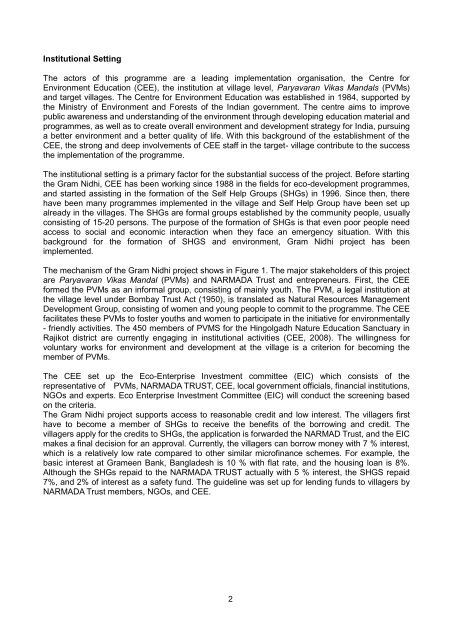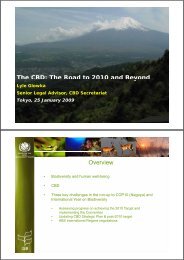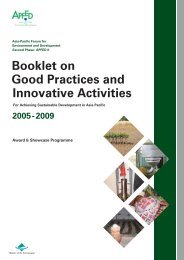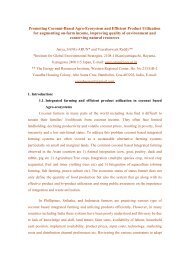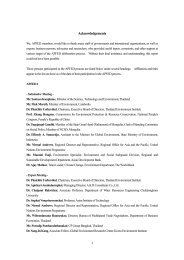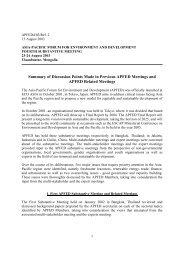Case Study Status Report on Gram Nidhi - APFED
Case Study Status Report on Gram Nidhi - APFED
Case Study Status Report on Gram Nidhi - APFED
Create successful ePaper yourself
Turn your PDF publications into a flip-book with our unique Google optimized e-Paper software.
Instituti<strong>on</strong>al Setting<br />
The actors of this programme are a leading implementati<strong>on</strong> organisati<strong>on</strong>, the Centre for<br />
Envir<strong>on</strong>ment Educati<strong>on</strong> (CEE), the instituti<strong>on</strong> at village level, Paryavaran Vikas Mandals (PVMs)<br />
and target villages. The Centre for Envir<strong>on</strong>ment Educati<strong>on</strong> was established in 1984, supported by<br />
the Ministry of Envir<strong>on</strong>ment and Forests of the Indian government. The centre aims to improve<br />
public awareness and understanding of the envir<strong>on</strong>ment through developing educati<strong>on</strong> material and<br />
programmes, as well as to create overall envir<strong>on</strong>ment and development strategy for India, pursuing<br />
a better envir<strong>on</strong>ment and a better quality of life. With this background of the establishment of the<br />
CEE, the str<strong>on</strong>g and deep involvements of CEE staff in the target- village c<strong>on</strong>tribute to the success<br />
the implementati<strong>on</strong> of the programme.<br />
The instituti<strong>on</strong>al setting is a primary factor for the substantial success of the project. Before starting<br />
the <strong>Gram</strong> <strong>Nidhi</strong>, CEE has been working since 1988 in the fields for eco-development programmes,<br />
and started assisting in the formati<strong>on</strong> of the Self Help Groups (SHGs) in 1996. Since then, there<br />
have been many programmes implemented in the village and Self Help Group have been set up<br />
already in the villages. The SHGs are formal groups established by the community people, usually<br />
c<strong>on</strong>sisting of 15-20 pers<strong>on</strong>s. The purpose of the formati<strong>on</strong> of SHGs is that even poor people need<br />
access to social and ec<strong>on</strong>omic interacti<strong>on</strong> when they face an emergency situati<strong>on</strong>. With this<br />
background for the formati<strong>on</strong> of SHGS and envir<strong>on</strong>ment, <strong>Gram</strong> <strong>Nidhi</strong> project has been<br />
implemented.<br />
The mechanism of the <strong>Gram</strong> <strong>Nidhi</strong> project shows in Figure 1. The major stakeholders of this project<br />
are Paryavaran Vikas Mandal (PVMs) and NARMADA Trust and entrepreneurs. First, the CEE<br />
formed the PVMs as an informal group, c<strong>on</strong>sisting of mainly youth. The PVM, a legal instituti<strong>on</strong> at<br />
the village level under Bombay Trust Act (1950), is translated as Natural Resources Management<br />
Development Group, c<strong>on</strong>sisting of women and young people to commit to the programme. The CEE<br />
facilitates these PVMs to foster youths and women to participate in the initiative for envir<strong>on</strong>mentally<br />
- friendly activities. The 450 members of PVMS for the Hingolgadh Nature Educati<strong>on</strong> Sanctuary in<br />
Rajikot district are currently engaging in instituti<strong>on</strong>al activities (CEE, 2008). The willingness for<br />
voluntary works for envir<strong>on</strong>ment and development at the village is a criteri<strong>on</strong> for becoming the<br />
member of PVMs.<br />
The CEE set up the Eco-Enterprise Investment committee (EIC) which c<strong>on</strong>sists of the<br />
representative of PVMs, NARMADA TRUST, CEE, local government officials, financial instituti<strong>on</strong>s,<br />
NGOs and experts. Eco Enterprise Investment Committee (EIC) will c<strong>on</strong>duct the screening based<br />
<strong>on</strong> the criteria.<br />
The <strong>Gram</strong> <strong>Nidhi</strong> project supports access to reas<strong>on</strong>able credit and low interest. The villagers first<br />
have to become a member of SHGs to receive the benefits of the borrowing and credit. The<br />
villagers apply for the credits to SHGs, the applicati<strong>on</strong> is forwarded the NARMAD Trust, and the EIC<br />
makes a final decisi<strong>on</strong> for an approval. Currently, the villagers can borrow m<strong>on</strong>ey with 7 % interest,<br />
which is a relatively low rate compared to other similar microfinance schemes. For example, the<br />
basic interest at <strong>Gram</strong>een Bank, Bangladesh is 10 % with flat rate, and the housing loan is 8%.<br />
Although the SHGs repaid to the NARMADA TRUST actually with 5 % interest, the SHGS repaid<br />
7%, and 2% of interest as a safety fund. The guideline was set up for lending funds to villagers by<br />
NARMADA Trust members, NGOs, and CEE.<br />
2


